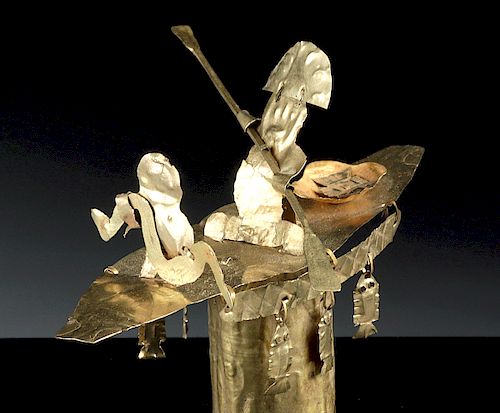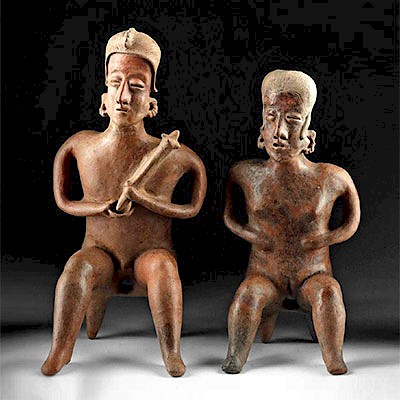Moche Gold Scepter Finial of Fishing Vessel - 14.9 g
Lot 143e
About Seller
Artemis Gallery
686 S Taylor Ave, Ste 106
Louisville, CO 80027
United States
Selling antiquities, ancient and ethnographic art online since 1993, Artemis Gallery specializes in Classical Antiquities (Egyptian, Greek, Roman, Near Eastern), Asian, Pre-Columbian, African / Tribal / Oceanographic art. Our extensive inventory includes pottery, stone, metal, wood, glass and textil...Read more
Estimate:
$7,500 - $9,500
Absentee vs Live bid
Two ways to bid:
- Leave a max absentee bid and the platform will bid on your behalf up to your maximum bid during the live auction.
- Bid live during the auction and your bids will be submitted real-time to the auctioneer.
Bid Increments
| Price | Bid Increment |
|---|---|
| $0 | $25 |
| $300 | $50 |
| $1,000 | $100 |
| $2,000 | $250 |
| $5,000 | $500 |
| $10,000 | $1,000 |
| $20,000 | $2,500 |
| $50,000 | $5,000 |
| $100,000 | $10,000 |
| $200,000 | $20,000 |
About Auction
By Artemis Gallery
May 23, 2019
Set Reminder
2019-05-23 10:00:00
2019-05-23 10:00:00
America/New_York
Bidsquare
Bidsquare : Exceptional Day 2 Ethnographic Tribal Fossils
https://www.bidsquare.com/auctions/artemis-gallery/exceptional-day-2-ethnographic-tribal-fossils-4136
Day 2 of an important 2-day auction featuring exceptional ethnographic art from around the world. Today's sale will feature Pre-Columbian from the ancient americas, Native American, African / Tribal, Oceanic, Spanish Colonial, and incredible Fossils. Artemis Gallery info@artemisgallery.com
Day 2 of an important 2-day auction featuring exceptional ethnographic art from around the world. Today's sale will feature Pre-Columbian from the ancient americas, Native American, African / Tribal, Oceanic, Spanish Colonial, and incredible Fossils. Artemis Gallery info@artemisgallery.com
- Lot Description
Pre-Columbian, North Coast Peru, Mochica, ca. 100 to 300 CE. A spectacular gold scepter finial comprised of 82% gold (equivalent to 18K+) depicting two individuals in a caballito de tortora - a reed boat used by Peruvian fisherman - with six endearing gold fish danglers suspended from gold horizontal elements adorned by an impressed cross-hatched pattern below the boat. The boatman - holding a long oar and wearing a tumi shaped headdress - most likely represents a Moche lord. Notice the wonderful facial features and decorative ornamentation on his headdress - all in repousse. The more petite figure at the opposite end of the vessel - likely a child with delineated facial features, nipples, and belly button - holds a slithering eel. Behind the rower, at the rear end of the boat is an olla with a fish in it - the catch of the day! Size: 3.75" W x 3.625" H (9.5 cm x 9.2 cm); 6.25" H (15.9 cm) on included custom stand. Closed case measures 5.875" W x 7.875" H (14.9 cm x 20 cm); total weight: 14.9 grams; precious metal quality: 82% gold (equivalent to 18K+)
The caballito de tortura sits upon a cylindrical lower section designed to fit the top of a scepter. This iconography extends back to pottery dating some 3,000 years ago. Caballito de tortora (little reed horses) are so named for the straddled manner in which they are ridden. Fishermen have traditionally used them to collect fish in the inner cavity and transport nets. Of course, caballito de tortora is not the original name, since horses were unknown to South America until the Spanish conquest of the Inca Empire.
Note that caballitos de tortora are made from the same reed, the totora (Schoenoplectus californicus subsp. tatora), used by the Uru people on Lake Titicaca. One cannot help but wonder if this iconography may by extension also reference to the legend of El Dorado. The legend of El Dorado first captured the imaginations of Spanish conquistadors in the 16th century, luring them from the Old World to the New World in search of precious goldworks. Lore of "El Hombre Dorado" (The Golden Man) or "El Rey Dorado" (The Golden King) involved a mythical Muisca chief of Colombia who according to legend had covered himself entirely in gold dust, created a luxurious golden raft, and offered coveted treasures to the Guatavita Goddess in her sacred lake.
It should be said that any goldwork from the Moche is exceedingly rare, as their treasures were targeted by plunderers during Colonial times. Heidi King of the Metropolitan Museum of Art in New York offers the following explanation in "The Art of Precolumbian Gold": "The Mochica or Moche as they are also known, built their capital in the dry, coastal valley of Moche, where the main construction was the Huaca del Sol, the so-called Pyramid of the Sun, the largest adobe structure built in Pre-Columbian South America. The great pyramid, made of over 143 million adobe bricks, was clearly visible and easily accessible during Colonial times, and it received extraordinary attentions from early treasure hunters (Bray this volume). As a result of such attentions, little of the wealth in precious metals that the Moche peoples are believed to have possessed remains in its ancient form today. Those works that do remain are all the more important because of their rarity." (The Art of Precolumbian Gold: The Jan Mitchell Collection" edited by Julie Jones. Boston: Little Brown & Company, 1985, p. 212)
Provenance: private Hawaii, USA collection; ex-Ian Arundel collection, Old Curiosity Cabinet, Los Angeles, California, USA
All items legal to buy/sell under U.S. Statute covering cultural patrimony Code 2600, CHAPTER 14, and are guaranteed to be as described or your money back.
A Certificate of Authenticity will accompany all winning bids.
We ship worldwide and handle all shipping in-house for your convenience.
#144358Just a few tiny nicks to peripheries of boat and child's head. Perforation at top of child's head suggests that he may have worn a headdress. Two perforations at lower end of cylindrical base of the finial were for attaching to scepter. Minor bending and creasing to gold sheet in areas. All in all, a downright fabulous example.Condition
- Shipping Info
-
All shipping is handled in-house for your convenience. Your invoice from Artemis Gallery will include shipping calculation instructions. If in doubt, please inquire BEFORE bidding for estimated shipping costs for individual items.
-
- Buyer's Premium



 EUR
EUR CAD
CAD AUD
AUD GBP
GBP MXN
MXN HKD
HKD CNY
CNY MYR
MYR SEK
SEK SGD
SGD CHF
CHF THB
THB

















